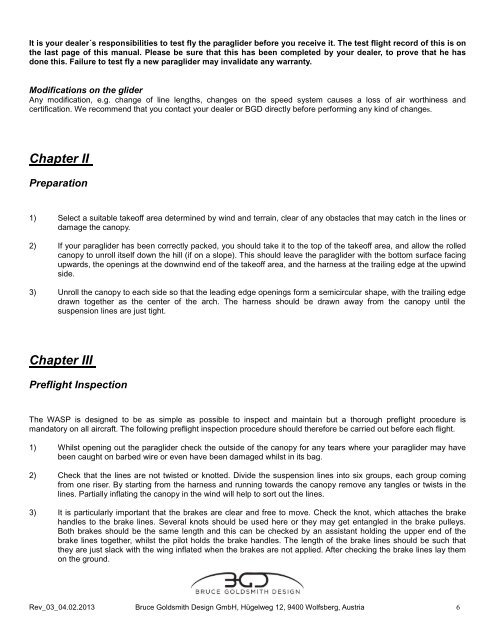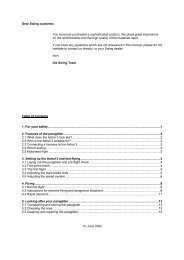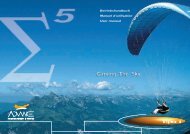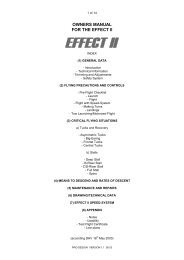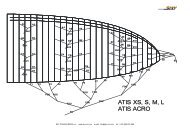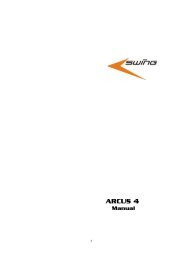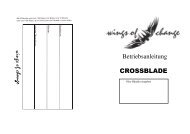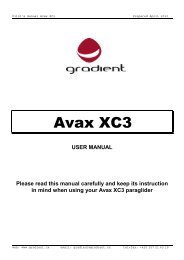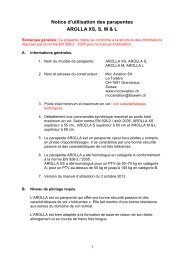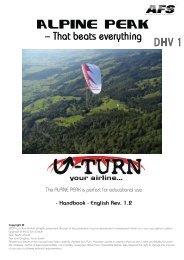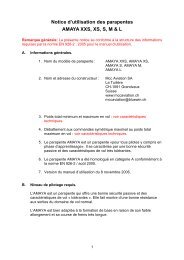Wasp - Manuel d'utilisation - Bruce Goldsmith Design
Wasp - Manuel d'utilisation - Bruce Goldsmith Design
Wasp - Manuel d'utilisation - Bruce Goldsmith Design
Sie wollen auch ein ePaper? Erhöhen Sie die Reichweite Ihrer Titel.
YUMPU macht aus Druck-PDFs automatisch weboptimierte ePaper, die Google liebt.
It is your dealer´s responsibilities to test fly the paraglider before you receive it. The test flight record of this is on<br />
the last page of this manual. Please be sure that this has been completed by your dealer, to prove that he has<br />
done this. Failure to test fly a new paraglider may invalidate any warranty.<br />
Modifications on the glider<br />
Any modification, e.g. change of line lengths, changes on the speed system causes a loss of air worthiness and<br />
certification. We recommend that you contact your dealer or BGD directly before performing any kind of changes.<br />
Chapter II<br />
Preparation<br />
1) Select a suitable takeoff area determined by wind and terrain, clear of any obstacles that may catch in the lines or<br />
damage the canopy.<br />
2) If your paraglider has been correctly packed, you should take it to the top of the takeoff area, and allow the rolled<br />
canopy to unroll itself down the hill (if on a slope). This should leave the paraglider with the bottom surface facing<br />
upwards, the openings at the downwind end of the takeoff area, and the harness at the trailing edge at the upwind<br />
side.<br />
3) Unroll the canopy to each side so that the leading edge openings form a semicircular shape, with the trailing edge<br />
drawn together as the center of the arch. The harness should be drawn away from the canopy until the<br />
suspension lines are just tight.<br />
Chapter III<br />
Preflight Inspection<br />
The WASP is designed to be as simple as possible to inspect and maintain but a thorough preflight procedure is<br />
mandatory on all aircraft. The following preflight inspection procedure should therefore be carried out before each flight.<br />
1) Whilst opening out the paraglider check the outside of the canopy for any tears where your paraglider may have<br />
been caught on barbed wire or even have been damaged whilst in its bag.<br />
2) Check that the lines are not twisted or knotted. Divide the suspension lines into six groups, each group coming<br />
from one riser. By starting from the harness and running towards the canopy remove any tangles or twists in the<br />
lines. Partially inflating the canopy in the wind will help to sort out the lines.<br />
3) It is particularly important that the brakes are clear and free to move. Check the knot, which attaches the brake<br />
handles to the brake lines. Several knots should be used here or they may get entangled in the brake pulleys.<br />
Both brakes should be the same length and this can be checked by an assistant holding the upper end of the<br />
brake lines together, whilst the pilot holds the brake handles. The length of the brake lines should be such that<br />
they are just slack with the wing inflated when the brakes are not applied. After checking the brake lines lay them<br />
on the ground.<br />
Rev_03_04.02.2013 <strong>Bruce</strong> <strong>Goldsmith</strong> <strong>Design</strong> GmbH, Hügelweg 12, 9400 Wolfsberg, Austria 6


